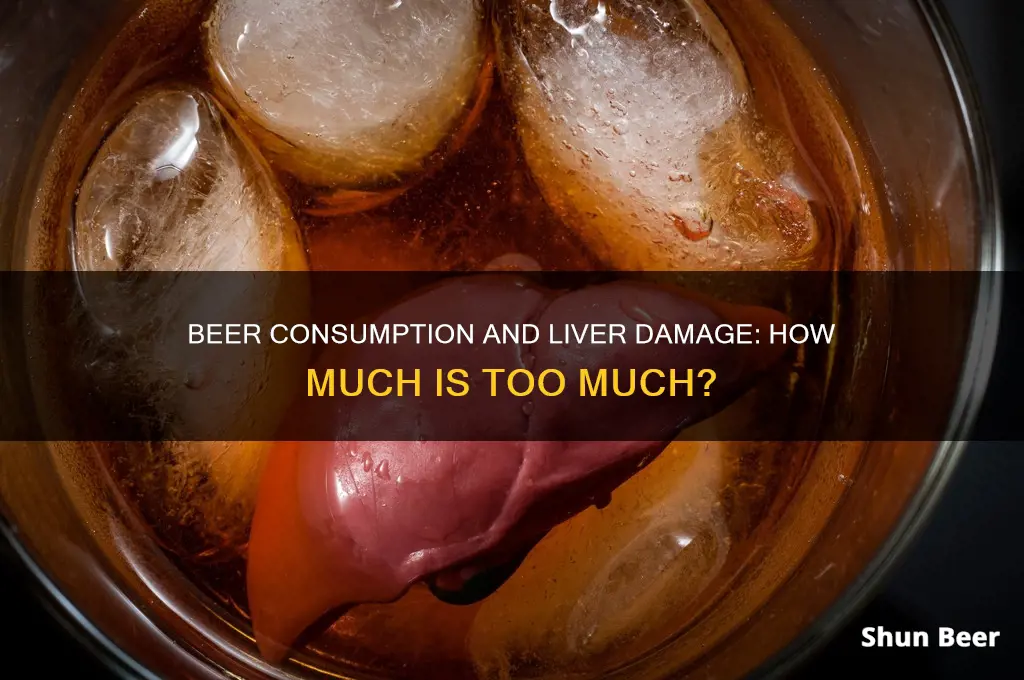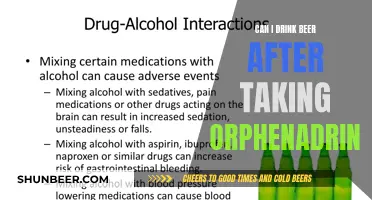
Alcohol-related liver disease is a serious condition that can lead to liver cirrhosis, a potentially fatal illness. The threshold for high risk of alcoholic hepatitis is generally considered to be 3-4 drinks per day over an extended period, with those who develop cirrhosis often drinking more than 6 servings of alcohol per day. Binge drinking is also a risk factor, with more than 4-5 servings of alcohol in a 2-hour period potentially causing liver damage.
The amount of alcohol it takes to damage the liver varies from person to person, and is influenced by factors such as genetics, body weight, metabolic risk factors, and drinking patterns. Women may be at higher risk of liver damage compared to men, even with little alcohol consumption.
The early stages of alcohol-related liver disease often have no symptoms, but signs may include pain or discomfort in the upper right side of the abdomen, fatigue, or unexplained weight loss. As the disease progresses, symptoms can include jaundice, swelling of the ankles and feet, and increased sensitivity to illness.
To improve liver health, it is recommended to reduce alcohol intake, eat a healthy diet, exercise regularly, and maintain a healthy weight.
| Characteristics | Values |
|---|---|
| Number of drinks per day for men that increases risk of liver disease | More than 2 |
| Number of drinks per day for women that increases risk of liver disease | More than 1 |
| Number of drinks per day that increases risk of alcoholic hepatitis | 3-4 |
| Number of drinks per day that increases risk of cirrhosis | More than 6 |
| Number of drinks in a 2-hour period that is considered binge drinking | More than 4-5 |
| Number of years of heavy drinking that can lead to alcoholic hepatitis | Several |
| Number of years of heavy drinking that can lead to cirrhosis | More than 10 |
| Percentage of heavy drinkers that develop cirrhosis | 5% |
| Number of weeks of binge drinking that can cause early liver damage | 7 |
What You'll Learn

Alcoholic Fatty Liver Disease
Fatty liver disease rarely causes any symptoms, but it is a warning sign that you are drinking at a harmful level. Symptoms may include tiredness and discomfort in the upper right side of the abdomen. It is important to note that this form of liver disease is often entirely reversible if you stop drinking alcohol.
If fatty liver disease progresses without being addressed, it can lead to alcoholic hepatitis, which is a more serious condition. Hepatitis refers to acute injury or inflammation of the liver cells. This condition can be asymptomatic but is sometimes associated with abdominal pain, vomiting, dehydration, and acute liver failure, which can be life-threatening. While alcoholic hepatitis can often be treated in a hospital with supportive care, it can sometimes worsen and cause liver failure and death. Therefore, careful monitoring is necessary.
The final stage of alcohol-related liver disease is cirrhosis, which involves the development of fibrosis and scarring of the liver, as well as permanent death of liver cells. Cirrhosis is largely irreversible, and patients with this condition have very high mortality rates. Thus, the best treatment for cirrhosis, like the other forms of alcohol-related liver disease, is to avoid drinking alcohol entirely.
Drinking Beer While on Macrobid: What You Need to Know
You may want to see also

Alcoholic Hepatitis
- Onset of jaundice within 60 days of heavy alcohol consumption (more than 50 g/day) for a minimum of 6 months.
- Serum bilirubin levels greater than 3 mg/dL.
- Elevated aspartate aminotransferase (AST) levels ranging from 50 U/L to 400 U/L.
- AST:ALT (alanine aminotransferase) ratio of more than 1.5.
- No other apparent cause of acute hepatitis.
The clinical presentation of alcoholic hepatitis can range from mild to severe. Mild cases may present with fever, right upper quadrant pain or discomfort, and elevated aminotransferase levels that normalise with sobriety. In contrast, severe cases may include jaundice, ascites, hepatic encephalopathy, and coagulopathy. The physical examination may reveal tachycardia, tachypnea, fever, an enlarged liver, and signs of portal hypertension.
Treatment for alcoholic hepatitis focuses on abstinence from alcohol and adequate nutritional support. Glucocorticoids, such as prednisolone, may be administered to reduce inflammation and promote anti-inflammatory gene expression. However, long-term benefits of these medications remain questionable. In severe cases, liver transplantation may be considered, although this is often complicated by social and ethical concerns, as well as organ shortages.
The prognosis for alcoholic hepatitis varies depending on the severity of the condition. Mild cases typically resolve completely with the cessation of alcohol consumption. However, severe cases are associated with a 30-day mortality rate of 30-50%, and a six-month mortality rate of approximately 40%. The presence of jaundice and hepatic encephalopathy at the time of presentation indicate a poorer outcome.
Exploring James Bond's Drink Preferences: Beer or Not?
You may want to see also

Alcoholic Cirrhosis
Cirrhosis is dangerous because it impairs the liver's ability to function properly. The liver is responsible for a wide variety of body functions, including detoxifying blood and producing bile to aid digestion. As cirrhosis progresses, the liver becomes unable to carry out these functions, which can lead to severe illness and even liver failure.
The exact amount of alcohol that will lead to cirrhosis varies from person to person. However, it is generally agreed that drinking more than two drinks per day consistently increases the risk of liver disease. Binge drinking—consuming more than 4-5 servings of alcohol in a 2-hour period—can also contribute to liver damage.
People who develop cirrhosis often drink more than 6 servings of alcohol per day and have more than 10 years of heavy consumption. It is estimated that 50% of men who drink 10 servings of alcohol per day for 20 years will develop cirrhosis. However, it's important to note that even occasional binge drinking over a shorter period of time can cause early stages of liver damage.
The best way to prevent alcoholic cirrhosis is to avoid heavy drinking and binge drinking. If you are concerned about your drinking habits or think you may have liver damage, it's important to consult with a doctor.
Kicking the Beer Habit: A Tough But Necessary Journey
You may want to see also

Risk Factors for Alcohol-Related Liver Disease
Alcohol-related liver disease is a common but preventable condition. The liver is responsible for processing alcohol, and when you drink excessively, it puts a strain on this vital organ, causing inflammation and cell damage. The risk factors for alcohol-related liver disease include:
- Heavy alcohol consumption: Regularly drinking more than the recommended amount increases the risk of liver disease. Heavy alcohol use is defined as consuming more than 14 drinks per week for men and more than 7 drinks per week for women.
- Binge drinking: Consuming a large amount of alcohol in a short period can also lead to liver damage. Binge drinking is typically defined as having more than 3-5 drinks in a 2-hour period.
- Duration of drinking: The longer a person drinks heavily, the higher the risk of liver damage. People with alcoholic hepatitis often have a history of heavy drinking for several years, while those with cirrhosis may have a decade or more of heavy consumption.
- Gender: Women are more susceptible to alcohol-related liver disease than men.
- Obesity and diet: A high-fat diet and obesity increase the risk of alcoholic liver disease.
- Genetic factors: Research suggests possible genetic links, but this area requires further investigation.
- Concurrent conditions: Individuals with hepatitis C or hepatitis B infection are at an increased risk of alcohol-related liver disease.
- Age: Older individuals may be at higher risk, with a higher prevalence of alcoholic liver disease in those over 40.
It is important to note that the development of liver disease is highly variable among individuals, and other factors such as drinking patterns, genetics, BMI, diet, and exercise can also play a role. Additionally, the severity of liver damage depends on the quantity and duration of alcohol consumption, with higher consumption and longer durations increasing the risk of irreversible damage.
Beer Drinking: Why Some People Can Handle More
You may want to see also

Steps to Improve Liver Health
While there is no exact answer to how much beer one can drink before liver damage occurs, it is known that the longer and heavier one drinks, the more likely they are to develop liver damage. Generally, consuming more than two drinks per day increases the risk of liver disease. Binge drinking, which is more than 4-5 servings of alcohol in a 2-hour period, can also cause liver damage.
Know your risk factors
Talk to your doctor about your family history of liver disease and be honest about your alcohol consumption. Get tested for hepatitis C, as many people with the infection are unaware they have it. Hepatitis B and C are viral diseases that can lead to chronic conditions and destroy your liver.
Limit alcohol consumption
Reduce your risk of alcohol-related liver conditions by limiting your alcohol intake. This means having less than two drinks per day for men and one drink per day for women. Remember that a standard drink in the US is roughly 14 grams of alcohol, so be mindful of how much alcohol is in your drink.
Be cautious when taking medications
Read the instructions carefully before taking any over-the-counter or prescription medications. Avoid drinking alcohol while taking certain medications, as it can cause injury to your liver or kidneys.
Avoid drug use and overuse of medications
The liver breaks down everything you put in your body, so using drugs incorrectly or chronically can hurt its function. This includes steroids, inhalants, pain relievers, and street drugs like heroin, which increase the risk of catching viral hepatitis.
Maintain a healthy lifestyle
Being overweight, having type 2 diabetes, high blood pressure, high cholesterol, or high triglycerides can put you at risk for metabolic dysfunction-associated steatotic liver disease (MASLD). Exercise, get enough sleep, and follow a Mediterranean or anti-inflammatory diet to support your liver and overall health. Quit smoking, as it can negatively affect your liver.
Beer Drinking and Liver Damage: What's the Link?
You may want to see also
Frequently asked questions
It is not known exactly how much or how long you have to drink to develop permanent liver damage. The longer and more heavily one drinks, the more likely they are to develop liver damage. Generally, more than two drinks per day increases your risk of liver disease.
Many people with liver disease have no symptoms at all. When symptoms are present, they may include:
- Tenderness in the area of the liver
- Unexplained weight loss
- Nausea or loss of appetite
- Jaundice (yellowing of the skin)
- Swelling in the ankles and feet
- Increased sensitivity to illness
There are several steps you can take to help improve the health of your liver. One of them is to reduce your alcohol intake. The Centers for Disease Control and Prevention (CDC) defines moderate alcohol consumption as up to one drink per day for women and up to two drinks per day for men.







